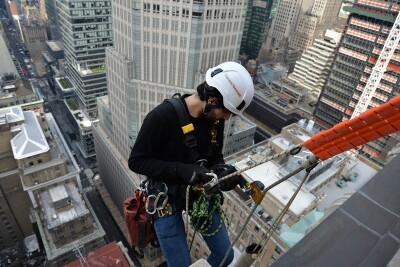The challenges that construction professionals deal with when it comes to effectively leveraging drone technology are both common and profound. With regulation no longer serving as the primary barrier to entry for most operators, sorting through the logistics of what it means to efficiently gather, process and integrate drone data have shifted to the top of mind for many professionals. AUVSI's XPONENTIAL 2017 event saw numerous companies announce solutions that are designed to do just that.
 DroneDeploy announced they have partnered with DJI to bring a complete drone solution to construction professionals. The DroneDeploy & DJI Construction Mapping Package includes a one-year Pro or Business software subscription to the DroneDeploy platform, the DJI Phantom 4 Pro drone and other drone accessories.Elsewhere, the construction segment is one of the many that Parrot is looking to serve with their new packages aimed at small businesses. Drones in this new division are designed to make adoption that much easier for construction professionals.This push to create drone options and solutions that allow construction professionals to more easily adopt the technology is nothing new. We’ve talked with Kespry CEO George Mathew about what it means for his company to be able to offer an integrated end-to-end drone solution along with their partnership with John Deere. We’ve also explored how Airware’s acquisition of Redbird plus their work with Caterpillar to create and provide drone solutions that make sense for construction, mining and quarrying organizations. Additionally, companies like Uplift Data Partners and Identified Technologies have created products and services that are designed to specifically serve this market.It’s been well established that many construction professionals realize UAVs can do beneficial things like enable better visualizations and more effective collaboration, but they often encounter challenges when it comes to sorting out exactly what those benefits look like. The push we’re seeing at XPONENTIAL to create and offer complete drone solutions is a recognition of this challenge, as all of the options above are designed to ensure that stakeholders won’t be forced to configure drone hardware or software. Few have the time, energy or patience to sort through such details. They don’t want to configure a solution. They just want something that works.It’s a desire that extends beyond the construction segment, but seeing so many different organizations focus on this industry is telling for reasons that go beyond the bottom line. We make it a point not to get caught up in the hype associated with drone technology, but with construction totaling $1.8 trillion in the United States in 2016, it’s easy to see what kind of difference any improvement to efficiency can make. Various drone companies are doing everything they can to show professionals in this space how their solution can create and enable these improvements, because they know how powerful they’ll be for everyone involved when they’re deployed at scale.What that deployment looks like is equally important, because that process could be incredibly influential on how the technology is adopted in other industries. Some have argued that drones might have an even bigger impact in industries like agriculture and utility inspections, but with concerns about operating beyond visual line of sight (BVLOS), many are still leery of fully embracing the technology. If the construction industry can showcase what sensible adoption looks like, it will be easier to extrapolate that same model elsewhere and in different ways.Seeing so many different companies push to create and showcase a complete drone solution is an indication of where the drone industry is headed, as this push will define what tools make sense for professionals in construction and beyond. Doing so will help define what the technology’s transition into being another tool for the toolkit actually looks like.
DroneDeploy announced they have partnered with DJI to bring a complete drone solution to construction professionals. The DroneDeploy & DJI Construction Mapping Package includes a one-year Pro or Business software subscription to the DroneDeploy platform, the DJI Phantom 4 Pro drone and other drone accessories.Elsewhere, the construction segment is one of the many that Parrot is looking to serve with their new packages aimed at small businesses. Drones in this new division are designed to make adoption that much easier for construction professionals.This push to create drone options and solutions that allow construction professionals to more easily adopt the technology is nothing new. We’ve talked with Kespry CEO George Mathew about what it means for his company to be able to offer an integrated end-to-end drone solution along with their partnership with John Deere. We’ve also explored how Airware’s acquisition of Redbird plus their work with Caterpillar to create and provide drone solutions that make sense for construction, mining and quarrying organizations. Additionally, companies like Uplift Data Partners and Identified Technologies have created products and services that are designed to specifically serve this market.It’s been well established that many construction professionals realize UAVs can do beneficial things like enable better visualizations and more effective collaboration, but they often encounter challenges when it comes to sorting out exactly what those benefits look like. The push we’re seeing at XPONENTIAL to create and offer complete drone solutions is a recognition of this challenge, as all of the options above are designed to ensure that stakeholders won’t be forced to configure drone hardware or software. Few have the time, energy or patience to sort through such details. They don’t want to configure a solution. They just want something that works.It’s a desire that extends beyond the construction segment, but seeing so many different organizations focus on this industry is telling for reasons that go beyond the bottom line. We make it a point not to get caught up in the hype associated with drone technology, but with construction totaling $1.8 trillion in the United States in 2016, it’s easy to see what kind of difference any improvement to efficiency can make. Various drone companies are doing everything they can to show professionals in this space how their solution can create and enable these improvements, because they know how powerful they’ll be for everyone involved when they’re deployed at scale.What that deployment looks like is equally important, because that process could be incredibly influential on how the technology is adopted in other industries. Some have argued that drones might have an even bigger impact in industries like agriculture and utility inspections, but with concerns about operating beyond visual line of sight (BVLOS), many are still leery of fully embracing the technology. If the construction industry can showcase what sensible adoption looks like, it will be easier to extrapolate that same model elsewhere and in different ways.Seeing so many different companies push to create and showcase a complete drone solution is an indication of where the drone industry is headed, as this push will define what tools make sense for professionals in construction and beyond. Doing so will help define what the technology’s transition into being another tool for the toolkit actually looks like. 




.jpg.small.400x400.jpg)










Comments